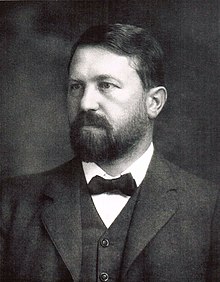Theodor Boveri
Theodor Boveri | |
|---|---|
 | |
| Born | 12 October 1862 |
| Died | 15 October 1915 (aged 53) |
| Nationality | German |
| Known for | Embryonic development Boveri–Sutton chromosome theory Centrosome Chromosome theory of cancer |
| Spouse | Marcella Boveri |
| Children | Margret Boveri |
| Scientific career | |
| Fields | Genetics, Cell biology |
Theodor Heinrich Boveri (12 October 1862 – 15 October 1915) was a German zoologist, comparative anatomist and co-founder of modern cytology.[1] He was notable for the first hypothesis regarding cellular processes that cause cancer, and for describing chromatin diminution in nematodes.[2] His brother was industrialist Walter Boveri. Boveri was married to the American biologist Marcella O'Grady (1863–1950).[3] Their daughter Margret Boveri (1900–1975) became one of the best-known journalists in post-World War II Germany.[4]
Work
[edit]Using an optical microscope, Boveri examined the processes involved in the fertilization of the animal egg cell; his favorite research objects were the nematode Parascaris and sea urchins.
Boveri's work with sea urchins showed that it was necessary to have all chromosomes present in order for proper embryonic development to take place.[5] This discovery was an important part of the Boveri–Sutton chromosome theory.[6][7] He also discovered, in 1888, the importance of the centrosome for the formation of the spindle during mitosis in animal cells, which he described as the especial organ of cell division.[6] Boveri also discovered the phenomenon of chromatin diminution during embryonic development of the nematode Parascaris.[8][9]
Building on Carl Rabl's knowledge that chromosomes are also present between two nuclear divisions in the cell nucleus, he developed the concept of chromosome individuality, i.e. the assumption that chromosomes retain their individuality during interphase.[10] Through long experiments on sea urchin eggs, he was also able to prove that the various chromosomes contain different genetic makeup.[11]
He also reasoned in 1902 that a cancerous tumor begins with a single cell in which the makeup of its chromosomes becomes scrambled, causing the cells to divide uncontrollably.[7][12] He proposed carcinogenesis was the result of aberrant mitoses and uncontrolled growth caused by radiation, physical or chemical insults or by microscopic pathogens.[13][14] His assumption was initially rejected by medical professionals; it was only later that researchers such as Thomas Hunt Morgan in 1915 demonstrated that Boveri was correct.[15][16]
Boveri also described the structure of the kidneys in Amphioxus (Cephalochordata).[17][18]
References
[edit]- ^ Manchester, K L (July 1997). "Overlooked Nobel laureates". Adler Museum Bulletin. 23 (2): 20–1. PMID 11619485.
- ^ Baltzer, F (May 1964). "Theodor Boveri". Science. 144 (3620): 809–15. Bibcode:1964Sci...144..809B. doi:10.1126/science.144.3620.809. PMID 14149391.
- ^ Satzinger, Helga (March 2008). "Theodor and Marcella Boveri: chromosomes and cytoplasm in heredity and development". Nat. Rev. Genet. 9 (3): 231–8. doi:10.1038/nrg2311. PMID 18268510. S2CID 15829893.
- ^ Baltzer, Fritz (1967). "Theodor Boveri: The Life of a Great Biologist 1862–1915". Archived from the original on 28 February 2005. Retrieved 22 July 2007.. Extract published in Gilbert, SF (2006). DevBio: a companion to Developmental Biology, 8th ed. Sinauer Associates.
- ^ Laubichler, Manfred D; Davidson Eric H (February 2008). "Boveri's long experiment: Sea urchin merogones and the establishment of the role of nuclear chromosomes in development". Dev. Biol. 314 (1): 1–11. doi:10.1016/j.ydbio.2007.11.024. PMC 2247478. PMID 18163986.
- ^ a b Maderspacher, Florian (2008). "Theodor Boveri and the natural experiment". Current Biology. 18 (7): R279 – R286. doi:10.1016/j.cub.2008.02.061. PMID 18397731. S2CID 15479331.
- ^ a b Wunderlich, Volker (September 2002). "JMM—past and present. Chromosomes and cancer: Theodor Boveri's predictions 100 years later". J. Mol. Med. 80 (9): 545–8. doi:10.1007/s00109-002-0374-y. PMID 12226736.
- ^ Moritz, K B; Sauer H W (February 1996). "Boveri's contributions to developmental biology—a challenge for today". Int. J. Dev. Biol. 40 (1): 27–47. PMID 8735909.
- ^ Stern, C (September 1950). "Boveri and the early days of genetics". Nature. 166 (4219): 446. Bibcode:1950Natur.166..446S. doi:10.1038/166446a0. PMID 14775717. S2CID 4189392.
- ^ Cremer, Thomas; Cremer, Marion (2010). "Chromosome Territories". Cold Spring Harbor Perspectives in Biology. 2 (3): a003889. doi:10.1101/cshperspect.a003889. ISSN 1943-0264. PMC 2829961. PMID 20300217.
- ^ Laubichler, Manfred D.; Davidson, Eric H. (1 February 2008). "Boveri's long experiment: Sea urchin merogones and the establishment of the role of nuclear chromosomes in development". Developmental Biology. 314 (1): 1–11. doi:10.1016/j.ydbio.2007.11.024. ISSN 0012-1606. PMC 2247478. PMID 18163986.
- ^ Boveri, Theodro (1902). "Über mehrpolige Mitosen als Mittel zur Analyse des Zellkerns". Verh Phys Med Gesellschaft Würzburg. 35: 67–90.
- ^ Boveri, Theodor (2008). "Concerning The Origin of Malignant Tumours". Journal of Cell Science. 121 (Supplement 1): 1–84. doi:10.1242/jcs.025742. PMID 18089652. S2CID 9033401.
- ^ Bignold, Leon P; Coghlan Brian L D, Jersmann Hubertus P A (July 2006). "Hansemann, Boveri, chromosomes and the gametogenesis-related theories of tumours". Cell Biol. Int. 30 (7): 640–4. doi:10.1016/j.cellbi.2006.04.002. PMID 16753311. S2CID 29706685.
- ^ Hardy, Paul A; Zacharias Helmut (December 2005). "Reappraisal of the Hansemann-Boveri hypothesis on the origin of tumors". Cell Biol. Int. 29 (12): 983–92. doi:10.1016/j.cellbi.2005.10.001. PMID 16314117. S2CID 12002052.
- ^ Manchester, K (1997). "The quest by three giants of science for an understanding of cancer". Endeavour. 21 (2): 72–6. doi:10.1016/S0160-9327(97)01030-2. PMID 9237430.
- ^ Holland, Nicholas D. (2017). "The long and winding path to understanding kidney structure in amphioxus - a review". The International Journal of Developmental Biology. 61 (10–11–12): 683–688. doi:10.1387/ijdb.170196nh. PMID 29319116.
- ^ Scheer, Ulrich (2018). "Boveri's research at the Zoological Station Naples: Rediscovery of his original microscope slides at the University of Würzburg". Marine Genomics. 40: 1–8. Bibcode:2018MarGn..40....1S. doi:10.1016/j.margen.2018.01.003. PMID 29426805.
Further reading
[edit]- Jane, Oppenheimer (1970–1980). "Boveri, Theodor". Dictionary of Scientific Biography. Vol. 2. New York: Charles Scribner's Sons. pp. 361–365. ISBN 978-0-684-10114-9.
External links
[edit]- Fritz Baltzer (1967), excerpt from Theodor Boveri: The life of a great biologist, 1862–1915. University of California Press, Berkeley; pp. 85–97.
- Markus Engstler and Ulrich Scheer, Theodor Boveri Resources and Virtual Library in Wuerzburg
- Peter Wolbert, Theodor Boveri (1862-1915)
